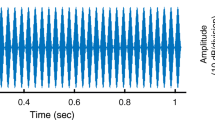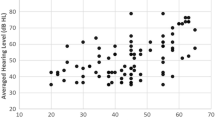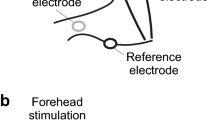ABSTRACT
Tone burst-evoked myogenic potentials recorded from tonically contracted sternocleidomastoid muscles (SCM) (cervical VEMP or cVEMP) are widely used to assess the vestibular function. Since the cVEMP response is mediated by the vestibulo-collic reflex (VCR) pathways, it is important to understand how the cVEMPs are determined by factors related to either the sensory components (vestibular end organs) or the motor components (SCM) of the VCR pathways. Compared to the numerous studies that have investigated effects of sound parameters on the cVEMPs, there are few studies that have examined effects of SCM-related factors on the cVEMPs. The goal of the present study is to fill this knowledge gap by testing three SCM-related hypotheses. The first hypothesis is that contrary to the current view, the cVEMP response is only present in the SCM ipsilateral to the stimulated ear. The second hypothesis is that the cVEMP response is not only dependent on tonic level of the SCM, but also on how the tonic level is achieved, i.e., by head rotation or head flexion. The third hypothesis is that the SCM is compartmented and the polarity of the cVEMP response is dependent on the recording site. Seven surface electrodes were positioned along the left SCMs in 12 healthy adult subjects, and tone bursts were delivered to the ipsilateral or contralateral ear (8 ms plateau, 1 ms rise/fall, 130 dB SPL, 50–4000 Hz) while subjects activated their SCMs by head rotation (HR condition) or chin downward head flexion (CD condition). The first hypothesis was confirmed by the finding that the contralateral cVEMPs were minimal at all recording sites for all the tested tones during both HR and CD conditions. The second hypothesis was confirmed by the finding that the ipsilateral cVEMPs were larger in HR condition than in CD condition at recording sites above and below the SCM midpoint. Finally, the third hypothesis was confirmed by the finding that the cVEMPs exhibit reversed polarities at the sites near the mastoid and the sternal head. These results improve understanding of the cVEMP generation and suggest that the SCM-related factors should be taken into consideration when developing standardized clinical cVEMP testing protocols.






Similar content being viewed by others
References
Colebatch JG, Halmagyi GM, Skuse NF (1994) Myogenic potentials generated by a click-evoked vestibulo-collic reflex. J Neurol Neurosurg Psychiatry 57:190–197
Colebatch JG, Rothwell JC (2004) Motor unit excitability changes mediating vestibulocollic reflexes in the sternocleidomastoid muscle. Clin Neurophysiol 115(11):2567–2573
Corneil BD, Olivier E, Richmond FJR, Loeb GE, Munoz DP (2001) Neck muscles in the rhesus monkey. II Electromyographic patterns of activation underlying postures and movements. J Neurophysiol 86:1729–1749
Graf W, De Waele C, Vidal PP (1994) Biomechanics, movement strategies and the evolution of the head-neck system in mammals. In: Delgado-Garcia JM, Godaux E, Vidal PP (eds) Information processing underlying gaze control. Elsevier, Amsterdam, pp 415–427
Halmagyi GM, Curthoys IS, Colebatch JG, AW ST (2005) Vestibular responses to sound. Ann N Y Acad Sci 1039:54–67 543
Li MW, Houlden D, Tomlinson RD (1999) Click evoked responses in sternocleidomastoid muscles: characteristics in normal subjects. J Vestib Res 9:327–334
McLoon LK (1998) Muscle fiber type compartmentalization and expression of an immature myosin isoform in the sternocleidomastoid muscle of rabbits and primates. J Neurol Sci 156:3–11
Murofushi T, Curthoys IS, Topple AN, Colebatch JG, Halmagyi GM (1995) Response of guinea pig primary vestibular neurons to clicks. Exp Brain Res 103:174–178
Richmond FJR, Singh K, Corneil BD (2001) Neck muscles in the rhesus monkey. I Muscle morphometry and histochemistry. J Neurophysiol 86:1717–1728
Rosengren SM, Welgampola MS, Colebatch JG (2010) Vestibular evoked myogenic potentials: past, present and future. Clin Neurophysiol 121:636–651
Todd NP, Cody FW, Banks JR (2000) A saccular origin of frequency tuning in myogenic vestibular evoked potentials? Implications for human responses to loud sounds. Hear Res 141:180–8
Uchino Y, Sasaki M, Sato H, Bai R, Kawamoto E (2005) Otolith and canal integration on single vestibular neurons in cats. Exp Brain Res 164(271–85):613
Wei W, Jeffcott B, Mustain B, Xu Y, Eby T, Zhu H, Tang X, Zhou W (2013) Vestibular-evoked myogenic potentials (VEMP) recorded from different sites of the sternocleidomastoid muscles in normal human subjects. JARO 14(1):37–47
Xu Y, Simpson I, Tang X, Zhou W (2009) Acoustic clicks activate both the canal and otolith vestibulo-ocular reflex pathways in behaving monkeys. JARO 10(4):569–77
Zhu H, Tang X, Wei W, Mustain W, Xu Y, Zhou W (2011) Click-evoked responses in vestibular afferents in rats. J Neurophysiol 106:754–763
Zhu H, Tang X, Wei W, Maklad A, Mustain W, Rabbitt R, Highstein S, Allison J, Zhou W (2014) Input-output functions of vestibular afferent responses to air-conducted clicks in rats. JARO 15(1):73–86
Zhou W, Mustain W, Simpson I (2004) Sound-evoked vestibulo-ocular reflexes(VOR) in trained monkeys. Exp Brain Res 156:129–134
Zhou W, Simpson I, Xu Y, Fong A (2005) Activity-dependent modulation: anon-linearity in the unilateral vestibulo-ocular reflex (VOR) pathways. ExpBrain Res 163:267–272
Zhou W, Xu Y, Simpson I, Cai YD (2007) Multiplicative computation inthe vestibulo-ocular reflex (VOR). J Neurophysiol 97:2780–2789
Acknowledgments
We thank Jerome Allison for the technical assistance.
Author information
Authors and Affiliations
Corresponding authors
Ethics declarations
The experimental protocol was approved by the Institutional Review Board at the University of Mississippi Medical Center.
Additional information
Alexander Ashford, Jun Huang and Chunming Zhang contributed equally to this work.
Rights and permissions
About this article
Cite this article
Ashford, A., Huang, J., Zhang, C. et al. The Cervical Vestibular-Evoked Myogenic Potentials (cVEMPs) Recorded Along the Sternocleidomastoid Muscles During Head Rotation and Flexion in Normal Human Subjects. JARO 17, 303–311 (2016). https://doi.org/10.1007/s10162-016-0566-8
Received:
Accepted:
Published:
Issue Date:
DOI: https://doi.org/10.1007/s10162-016-0566-8




